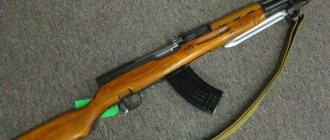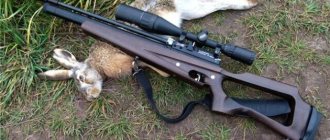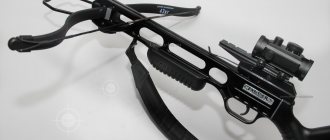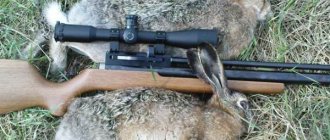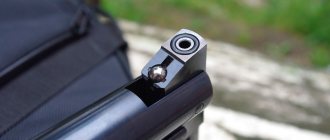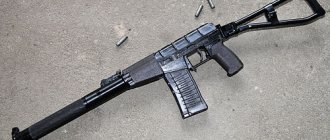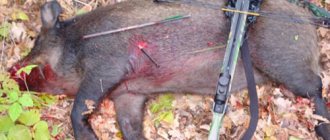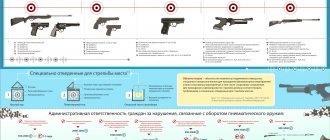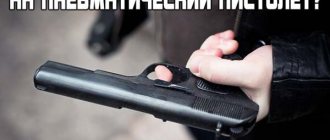A bear is a serious opponent, so hunting it requires not only high hunting skills and good preparation, but also a careful selection of weapons. This will not only allow you to get a trophy, but also save your life and health in the confrontation with such a beast.
Nowadays a huge number of different hunting weapons and ammunition are offered. Therefore, the problem is not in the search, but in choosing what suits you personally, your weapon and the situation. Let's try to figure this out.
Hunting specifics
The wild boar hunting season opens at the end of summer and continues throughout the fall. During this period, the boar gains its maximum weight. The tactics of approach hunting in autumn are determined by the habits and habits of the animal. For hunting, choose a day that is not hot with a light breeze. It is in this weather that the wild boar is most actively looking for food. At this moment he makes a lot of noise and you can find him in the forest by his characteristic sounds.
You need to approach the animal from the leeward side. The animal is able to smell a person from 500 meters away. Reservoirs can be a reference point for searching for wild boar. He is a big fan of swimming more than once a day. There are always traces of his hooves on the damp bank.
Expansive bullet
According to the majority of experienced hunters, the best results when shooting at a bear are provided by expansion-type ammunition. These are bullets that, once in the body of an animal, due to their design, increase the area of the affected surface, thereby increasing the damage inflicted on it and the stopping effect. The most common types of such ammunition are of two types: semi-jacketed (when the end of the bullet is not covered with a shell) and with an expansive cavity at the end. In addition, combined type ammunition is widespread, especially for rifled weapons.
In addition to industrial ammunition, hunters widely use homemade modified ones. As a rule, the tip of a conventional bullet is cut off, filed, or drilled out, which leads to increased deformation upon impact. But you need to remember that by making these changes to the bullet, you reduce its mass, which reduces its lethality.
Among shotgun ammunition, the best bullets for shooting bears are hollow-point bullets with a cylindrical groove in the middle, such as Stedenbach, Mayer, BS bullets , or a split-body bullet, such as the Jacana or Duplex Monolith .
For rifled weapons, it is advisable to take semi-jacketed bullets, especially those with a recess or drill at the end.
Weapons and equipment
They go hunting for wild boar with serious weapons. Shooting an animal in the head is prohibited. This way you can only hurt him. A wounded animal is very dangerous. His strength is greatly increased by the rage that flares up within him after being wounded. He can attack a hunter or rush into the thicket of the forest, destroying everything and everyone in his path.
Hunters must chase the boar until it is killed. You need to shoot at the boar's ear, neck, spine, heart or lungs. The bullet's penetrating force must be powerful enough. Preference in wild boar hunting is given to rifled weapons with a caliber of 7.62x51. Domestic Saiga guns may well be suitable
Characteristics of rifled weapons
| brand | Price, rub | Caliber, mm | Weight without cartridges kg | Length, cm | Barrel length, cm | Magazine capacity, pcs. |
| Saiga | 16500 | 7.62x39.7 | 3,8 | 106,6 | 52 | 5, 10 |
| Saiga M100 | 23500 | 7.62x63 | 3,77 | 110 | 55,4 | 3 |
| Saiga 308 | 24000 | 7.62x51 | 3,86 | 110 | 55,4 | 8 |
Those who do not have the right to a rifled weapon can go for a wild boar with a smooth-bore double-barreled shotgun with a caliber of 12 mm.
The hunter's autumn equipment consists of insulated and protective colors, sewn from a material that does not make unnecessary noise when moving. Clothes made of satin are best suited for hunting. You can cover your head with a cap or Panama hat with a mosquito net.
Boots can be chosen as a choice. Mandatory attributes of a hunter's equipment are: a sharp knife,
- compass;
- flashlight;
- matches;
- hatchet;
- bowler hat
The bandolier is attached to the hunter's belt. It is enough for 10 or 20 rounds. You can put a small supply of food and drink in your backpack.
Ammunition for smoothbore weapons
When hunting bears, smooth-bore weapons are used at distances of up to fifty meters. It is this distance that is guaranteed to allow you to hit the predator at the aiming point. This determines the use of such guns either when hunting in a den, or as a safety gun for other types of hunting or when finishing off.
Practice and recommendations from professionals say that in order to be guaranteed to kill a bear, the bullet that hits it must have an energy of about 8 – 10 J per kilogram of the predator’s live weight. For a bear weighing 200 kg, this is at least 1600 J. As you can see, this can only be achieved when shooting from a smooth barrel with a heavy bullet and a powerful cartridge charge. Guns of the appropriate caliber can provide this.
Caliber selection
12 gauge This is the optimal caliber for a bear gun. It is quite common, you can easily find all types of ammunition for it. A bullet of this caliber will have sufficient mass and, accordingly, energy to be guaranteed to kill a bear. As hunting wisdom says: “A large caliber “corrects” aiming errors.” Equipment and configuration of a cartridge for such a caliber again does not pose a problem.
16 gauge It also allows you to effectively hit bears at medium and short distances, but requires good hunting skills. It involves targeted shooting at places where the animal is sure to be hit: directly in the heart, neck, spine, etc. It is recommended to use cartridges with a large amount of gunpowder, up to Magnum.
20 gauge This caliber can be used on bears, but only with Magnum cartridges. Hunting with such a gun places high demands on hunting and shooting skills. It is advisable to shoot from a shelter or with backup.
28 cal . Not enough to ensure any guaranteed defeat of the bear. It can inflict noticeable wounds on the beast, but none of them are guaranteed to be fatal from the first shots.
Bullet selection
Now let's figure out which bullets are best suited for our purposes:
Field bullet
Not the best choice for bear hunting. This bullet has insufficient stopping power. In addition, when hit, it can become very deformed and destroyed, causing a large superficial wound, but weakly penetrating inside. Polev’s bullet is also capable of deflecting when it hits branches. All this makes it of little use against this predator.
Bullets duplex
The Duplex Monolit bullet appeared relatively recently, but has already proven itself well among large game hunters. This is an expansive explosive ammunition with a high stopping effect. It is a notched steel bullet pressed under pressure into a plastic shell.
Once in the animal’s body, it almost doubles the area of expansive impact, and then splits into six equal fragments, thereby further increasing the cone of damage. Its advantages include the absence of ricochet from grass and small branches. This ammunition will be optimal for bear hunting. The disadvantage is the relatively high price.
Bullet arrow
It looks like an aircraft bomb due to its “feather”. Equipped in a plastic container. It has good accuracy and penetrating ability, but has a weak stopping effect. The energy of this bullet is usually enough to kill a bear.
Sub-caliber bullet
A sub-caliber bullet makes it possible to shoot from tapered barrels, has a higher initial speed and allows you to hit a target at long distances. Moreover, the mass of the bullet is always less than that of a caliber bullet. As a result, it has much lower stopping power, and in addition, it easily ricochets off grass and other obstacles.
At close range, such a bullet will simply pierce the bear without having a noticeable stopping effect. Shooting at a bear from a smooth-bore weapon is rarely carried out at long distances, so the use of sub-caliber ammunition is at least impractical.
Brennicke's bullet
This heavy, powerful bullet performs well at distances up to 50 meters. It has good stopping power and penetration ability. At long distances, its hit accuracy suffers. This is one of the popular and common ammunition for bear hunting.
Hunting Permits
The shooting of animals is carried out on the basis of licenses issued by Rosselkhoznadzor or local authorities. Their validity period is limited. The license indicates the boundaries of the hunting area. As a rule, for wild boar hunting, a collective document is issued, which is provided to the foreman of the group of hunters.
All group members must have hunting licenses. On the back of the license, mandatory notes are made about the start of the hunt, its end, injury or fatal defeat of the animal.
The boundaries of the hunting area specified in the license can be crossed in case of pursuit of a wounded animal.
European hunters
Hunters in Europe are offered no less choice. In addition to the mentioned cartridges, European hunters widely use sets of 8X 57IRS cartridges; 9,ЗХ 74R—for fittings; 8X68, 9.3X62, 9.3X64 - for carbines; some cartridges are loaded with bullets weighing 17.5; 18.5; 19.5 g, which have E0 from 597 to 635 kgf-m. It is significant that we are talking about densely populated Europe with its not so large deer and wild boars... In Czechoslovakia, hunters are offered cartridges for rifled weapons of 11 calibers and 42 varieties for various types of hunting.
Hunting
The hunt begins with finding the animal's habitat. Having discovered traces of the presence of the animal, the hunters begin to surround the place where the boar was fattened, slowly squeezing the ring. This should be done as quietly and carefully as possible. Having sensed a person, a boar can hide for a while and then suddenly attack the person. You can protect yourself from direct attack by hiding behind a large tree or boulder.
A boar lying motionless after a shot may turn out to be alive. The wound will increase his strength. Pinned ears and ruffled stubble are a sure sign that the animal is hiding and waiting for a person to approach. The control shot should be fired into the ear. They go hunting in the evening. The boar is especially active in the dark. Therefore, a successful hunt ends closer to midnight.
M. Blum
Weapons and cartridges for bears
When hunting for bears, you can use smooth-bore weapons, combined and rifled. If you plan to shoot at distances no further than 50 m, then you should use a double-barreled smooth-bore weapon with two separately operating trigger mechanisms, i.e., guns with more than one trigger. It’s better to have both cylindrical barrels or cylinders with pressure. Self-loading weapons should not be used, even if they are well-debugged and tested by firing the cartridges with which you are going to hunt. The same applies to pump-action weapons, which, moreover, when walking or changing the position of the gun, make a clanging sound due to a loose connection with the forend of the rod for moving the bolt. A repeating weapon with a box magazine and a bolt action has a clear advantage in this regard, but it should not be used on a bear hunt if you plan to shoot at close range, since it does not always work perfectly.
The caliber of the weapon must be 12 or 16. Of course, if you have a gun chambered for 20-gauge magnum ammunition and have the appropriate ammunition, it can also be used for bear hunting. When shooting at a bear at a distance of more than 30 m, you should use only rifled weapons, but again not self-loading ones, but double-barreled rifles with a caliber of at least 9 mm. We don’t currently make domestic 9mm cartridges, but in some places they can be found on sale.
It must be said that at one time our industry produced double-barreled rifled shotguns TOZ-55 "Bison" chambered for 9×53 cartridges (according to the designation adopted in Europe, this cartridge should be called 9, Zx53R), and prototypes were even made for the European cartridge 9, Zx74R, but the block for it turned out to be weak, because the design was based on the well-known TOZ-34 gun and this gun did not pass the test. Naturally, if you have a foreign-made double-barreled rifle chambered for a cartridge no less powerful than the 9 cartridge, Zx74R, then with such a weapon you can hunt a bear even in a den. Of course, if you are going to shoot a bear not “shortly”, but at a decent distance, then you can use a foreign-made repeating carbine chambered for the 9.3×64 cartridge, since the Los-8″ prototypes chambered for this cartridge have remained experimental, and domestically produced 9.3×64 cartridges, developed by me, never began to be produced, although in 1989 two experimental batches of 14 thousand pieces were made and sent to Tula and Izhevsk. Of course, if you have a carbine chambered for a more powerful cartridge, then don’t hesitate and take it hunting.
If you do not know at what distance a bear can be encountered, then only a double-barreled or three-barreled combination gun will help you for a successful hunt. A smooth barrel or barrels of 12, 16 or 20 gauge are chambered for magnum cartridges, and a rifled barrel or two upper barrels are chambered for 9, 3x74R or more powerful cartridges. The tee version with two upper rifled barrels is preferable for bear hunting. So, you have got some idea about weapons for bear hunting; Now let's move on to the cartridges. To shoot a bear from a smooth-bore weapon, only bullet cartridges are used. Moreover, it should immediately be noted that the bullets should be heavy, and not lightweight or sub-caliber.
Shirinsky-Shikhmatov bullet:
|
By far the best bullet for bear hunting should be considered the bullet of Prince Andrei Aleksandrovich Shirinsky-Shikhmatov. S. A. Buturlin wrote about this bullet: “The most reliable projectile is, perhaps, the toss bullet of Prince Andrei Aleksandrovich Shirinsky-Shikhmatov. The advantage of this projectile is that when it hits the carcass of an animal, it breaks easily, without expending significant force of impact on the rupture, since the parts are already cut. Then it breaks in a very specific way, always in the same way, and not depending on the occasion. Finally, it breaks into pieces - four crosses and a bottom - large enough that each one inflicts large lesions, goes deep and hits the bones. The bottom even sometimes goes right through the bear...” Unfortunately, this bullet cannot be found on sale, but some hunters make it themselves.
| Brenneke bullet | Bullet "Brenneke" modified according to the author's recommendation |
Of the bullets currently sold, the most suitable for bear hunting can be considered the Brenneke bullet, but slightly modified. First of all, you should select bullets according to the diameter of the body (not counting the leading bands), which should be 0.5-0.7 mm less than the diameter of the strongest choke in your gun. After this, unscrew the screws that screw the greasy felt wad with cardboard spacers to the lead bullet head, and remove it all. Then take a longer screw, put on it two gaskets made of thick cardboard with a total thickness of 3 mm, two greased felt wads with a total thickness of 18-20 mm and another gasket with a thickness of 1.5-2.0 mm made of thick cardboard. Screw all this to the lead head. Such a bullet is placed directly on the powder charge.
| Cartridge equipped with a Brenneke bullet |
The absence of wads not connected to the bullet improves accuracy and its lethal effect. Of course, there are a lot of options for making bullets, but this is the most affordable. When shooting from a single-barreled Browning at 100 m, four bullets fell into a circle of 4.5 cm with 2.35 g of Sokol gunpowder (the temperature was about zero degrees). The following can be said about other bullets. In a 12-gauge shotgun, all bullet designs are quite heavy and, when combined with a powerful powder charge in a heavy shotgun, they will create the necessary killing effect. Prince A. A. Shirinsky-Shikhmatov used 10- or 12-gauge guns when hunting bears.
In 16 and 20 calibers, only bullets with a heavy head can be used, which must have two greasy felt wads, as described above. To equip bullet cartridges, you should take new polyethylene sleeves if the hunt will take place at a temperature not lower than 30 degrees below zero, and at lower temperatures you should take a new paper sleeve, but covering it with a protective composition against moisture, for example, a mixture of acetone with flammable photographic film washed from the emulsion .
It is best to press a “powerful chew” primer into the cartridges, since at low temperatures it best promotes the complete combustion of the powder charge. Weights of powder charges should be taken in accordance with the table, which recommends the weight of various powders for bullet cartridges with felt wads. Compared to cartridges with felt wads and cardboard spacers, for wood-fiber wads when equipped with Sokol gunpowder, the charge weight should be increased by 0.1 g, and when using polyethylene seals (placed directly on the gunpowder), wads and wads with concentrators should be reduced the charge of Sokol gunpowder is 0.2 g. Unfortunately, there is no data on other gunpowders, but the principle remains the same: with polyethylene wads and seals, the charge should be slightly reduced. Since powders can vary greatly in their characteristics from one batch to another, when loading cartridges, you should first of all be guided by the attached instructions or the minimum charge indicated in the table. Smokeless powder should be weighed on a pharmacy scale with an accuracy of plus or minus one hundredth of a gram, and smoky powder with an accuracy of plus or minus five hundredths of a gram.
You should know that such precision is necessary when weighing all types of powders. After all, the bullet must be placed in the animal exactly in the right place; this is not a shotgun shell consisting of many bullet pellets. If there is a large difference in the powder weights and the mass of the bullets, the accuracy, and therefore the accuracy, will be poor. This, of course, will affect the effectiveness of the hunt. In addition, it will be impossible to accurately zero the gun at different distances.
The bullets are inserted into the cartridge case using a hammer or other wooden punch, so that the elbow does not come off the table surface when inserting. The bullet in the case can either be rolled or closed with an asterisk crimp. The finished cartridge is checked to ensure that it fits easily into and out of your gun's chamber. Finished cartridges are tested by shooting for accuracy and accuracy at a distance of 50 m, and for accuracy at 25 and 75 m. Accuracy here means the amount of deviation of the point of impact from the aiming point, which is the smaller the better. At the same time, during such shooting, the excess or fall of the point of impact of bullets relative to the aiming point at different distances is determined, which makes it possible to make corrections when choosing an aiming point during hunting. During shooting, if the accuracy or sharpness of the fire is unsatisfactory (the depth of penetration of the bullet into the target material), the weight of the powder charge should be changed.
If the shooting accuracy is poor, you should gradually begin to reduce the powder charge. The battle can be considered excellent if, when shooting at a distance of 50 m, the bullets fit into a circle with a diameter of 10 cm; good - if the bullets do not come out of a circle with a diameter of 15 cm; satisfactory - when the bullets are located in a circle with a diameter of 20 cm. There is no need to check the sharpness of a bullet shot from a smoothbore gun, since with conventional charges at a distance of up to 50 m, all types of bullets have sufficient sharpness to hit a bear. Typically, when shooting at 50 m, bullets pierce a package of dry pine boards to a depth of 100 to 220 mm. All shooting must be carried out in the temperature conditions in which you will have to hunt.
A few words about the now practiced inscriptions on boxes of bullet cartridges or instructions for equipping cartridges with certain bullets. Everywhere it is written that bullets or bullet cartridges should be used in barrels with a muzzle constriction of no more than one mm. A very strange inscription. If we take into account the spread of bore diameters of 12-caliber guns, for example, in domestically produced shotguns, it ranges from 18.2 to 18.75 mm, i.e. the spread is 0.55 mm. This means that a choke of one mm for a gun with a bore of 18.2 mm will be equal to 17.2 mm, and for a gun with a bore of 18.75 mm a choke of the same one mm will be equal to a diameter of 17.75 mm. So what choke point are these bullets made for? Dont clear! The situation is further aggravated by the fact that a large number of foreign guns have appeared on sale. Therefore, I reiterate that you should pay special attention to the diameter of the strongest choke in your gun and match it with the body diameter of the bullets you purchase.
Table 1
Powder charge weights for bullet cartridges only with felt wads at different temperatures
| Powder type | Gun caliber | Gun weight* (kg) | Bullet weight** (g) | Powder weight (g) at air temperature C | ||
| + 20 | — 20 | — 40 | ||||
| Smokeless "Falcon"*** | 12 | 3,2-3,5 | 32-37,5 | 2,2 | 2,35 | 2,45 |
| 16 | 30,0-3,2 | 29-32 | 2,0 | 2,15 | 2,25 | |
| 20 | 2,6-3,1 | 27-31 | 1,6 | 1,75 | 1,85 | |
| Smokeless "Sunar" | 12 | 3,2-3,5 | 32-35 | 1,8-2,1 | 1,9-2,2 | 2,1-2,40 |
| 16 | 3,0-3,2 | 27-30 | 1,4-1,7 | 1,5-1,8 | 1,65-1,95 | |
| 20 | 2,6-3,1 | 23-25 | 1,2-1,5 | 1,3-1,65 | 1,45-1,80 | |
| Smokeless "Bars" | 12 | 3,2-3,5 | 32-35 | 2,1-2,4 | No data | No data |
| 16 | 3,0-3,2 | 28-31 | 1,7-2,1 | |||
| 20 | 2,6-3,1 | 24-25 | 1,4-1,8 | |||
| Smokeless "VUSD" | 12 | 3,2-3,5 | no more than 32 | 1,6 | No data | No data |
| 16 | 3,0-3,2 | no more than 28 | 1,5 | |||
| Smoky | 12 | 3,2-3,5 | 32-37,5 | 5,75-6,7 | 6,9-8,05 | 7,5-8,6 |
| 16 | 3,0-3,2 | 29-32 | 5,2-6,1 | 6,2-7,4 | 6,8-7,9 | |
| 20 | 2,6-3,1 | 27-31 | 4,3-5,5 | 5,1-6,5 | 5,6-7,0 | |
Powder weights are given as starting points for starting zeroing the weapon.
*Lighter guns and lighter bullets should not be used for bear hunting
**Cm. footnote *
***Data is given for those batches of Sokol gunpowder, on the cans of which the maximum permissible charge for 12 gauge is indicated, equal to 2.5 g
Factory-made hunting bullet cartridges of 12, 16 and 20 calibers are manufactured to special specifications with paper cartridges with a high metal base and felt wads. These cartridges can only be used in weapons that (as indicated in the specifications) have a muzzle constriction of no more than one mm. All bullet cartridges have a maximum pressure of no higher than 663 kgf/cm, and the speed of bullets at 10 m from the muzzle of the barrel is no less than 380 m/s. The following main types of bullets are used in these cartridges: Brenneke, Mayer turbine, Vyatka, Sputnik. Of these, only the Sputnik ball bullet is used in 16- and 20-gauge cartridges, the rest in 12-gauge cartridges.
The dispersion diameter when shooting at a distance of 45 m with cartridges with a Brenneke bullet should be no more than 60 cm, with Mayer and Vyatka bullets - no more than 50 cm, and with a Sputnik bullet of 12 and 16 calibers - no more than 80 and 70 cm, respectively. Try to get into a killer place with such accuracy! Unless at point blank range. Bullet cartridges are also available with other types of bullets, but I specifically provided data on some factory-made bullet cartridges to show the hunter that factory-made bullet cartridges should never be used on bear hunts. The cartridges must only be of your own equipment and shot from your gun.
table 2
Characteristics of some rifle cartridges that may be recommended for bear hunting.
| Cartridge name | Bullet weight (g) | Speed (m/s) at ranges (m) | Energy (kgcm) at ranges (m) | Maximum pressure kgf/cm2 | ||||||
| 0 | 100 | 200 | 300 | 0 | 100 | 200 | 300 | |||
| 8x68 | 14,5 | 870 | 780 | 695 | 620 | 559 | 450 | 357 | 284 | 3800 |
| 9.3x62 | 19,0 | 745 | 680 | 628 | 588 | 538 | 448 | 382 | 335 | 3400 |
| 9.3x64 | 19,0 | 785 | 725 | 672 | 627 | 597 | 509 | 437 | 381 | 3600 |
| 9.3x74R | 19,0 | 700 | 636 | 586 | 548 | 475 | 392 | 333 | 291 | 3000 |
| 9x53 Russia | 15 | 680 | 557 | 453 | 374 | 354 | 238 | 157 | 107 | 2000 |
| 7.62x53 Russia | 13 | 771 | 693 | 621 | 554 | 394 | 318 | 255 | 203 | 3150 |
It was previously mentioned that for shooting at a distance of more than 50 m, you should use rifled weapons chambered for 9x53 (9.3x53R) or 9.3x74R. In extreme cases, you can use weapons chambered for 7.62x53 (7.92x53R), but only during random encounters and with precise targeting at the slaughter site. The characteristics of these cartridges and similar ones are given in Table 2. The table with ballistic characteristics is given so that when choosing a foreign rifled weapon for bear hunting, select it for a cartridge whose ballistics approximately corresponds to the specified cartridges.
M. BLUM
